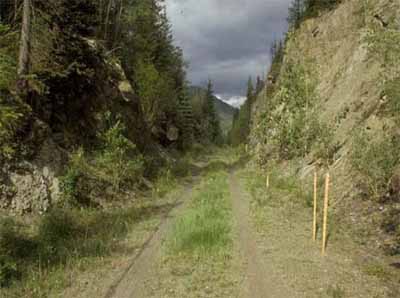Yellowhead Pass National Historic Site of Canada
Jasper National Park of Canada, Alberta

General view
© Jack Porter, Parks Canada Agency / Agence Parcs Canada, 2005.
Address :
Roadside pullout, 9 km west of Jasper on Highway 16, Jasper National Park of Canada, Alberta
Recognition Statute:
Historic Sites and Monuments Act (R.S.C., 1985, c. H-4)
Designation Date:
1971-05-27
Dates:
-
1820 to 1850
(Significant)
Event, Person, Organization:
-
Pierre Bostonais/Tête Jaune
(Person)
-
Sir Sanford Fleming
(Person)
-
David Thompson
(Person)
-
Grand Trunk Pacific Railway
(Organization)
-
Canadian Northern Railway
(Organization)
-
Internment camps
(Organization)
-
Jasper National Park
(Organization)
-
Mount Robson Provincial Park
(Organization)
-
Hudson's Bay Company
(Organization)
Other Name(s):
-
Yellowhead Pass
(Designation Name)
-
Leather Pass
(Other Name)
Research Report Number:
1971-06, 2006 SDC-007
DFRP Number:
15412 00
Plaque(s)
Existing plaque: Roadside pullout, 9 km west of Jasper on Highway 16, Alberta
This pass was used for brief periods from the mid 1820s to the early 1850s by the Hudsons Bay Company, principally to transport leather, especially moosehides, from the Saskatchewan District to its posts in New Caledonia. It derives its name from Pierre Bostonais, called "Tête Jaune", an Iroquois freeman active here in the early l9th century. Originally chosen by Sandford Fleming for the CPR, the Yellowhead Pass eventually became part of the Grand Trunk Pacific and Canadian Northern routes (now the CNR), and later still, a major highway crossing of the Rocky Mountains.
Description of Historic Place
The Yellowhead Pass National Historic Site of Canada is a historic travel corridor through the Rocky Mountains from Alberta to British Columbia. The pass is located in Jasper National Park of Canada at its eastern end and in Mount Robson Provincial Park at its western end. It is one of the lowest elevation passes across the Great Divide in the Northern Rockies. The official recognition refers to the cultural landscape of the pass and historic resources associated with the former railway roadbeds of the Grand Trunk Pacific Railway Company and Canadian Northern Railway Company.
Heritage Value
The Yellowhead Pass was designated a National Historic Site of Canada in 1971 because: it was used for brief periods from the mid-1820s to the 1850s by the Hudson’s Bay Company; and it became part of the Grand Trunk Pacific and the Canadian Northern Railway companies’ routes and a major highway crossing through the Rocky Mountains.
This pass was used for centuries by First Nations peoples, from about 1825 to the 1850s by the Hudson’s Bay Company principally to transport leather from the Saskatchewan District to its posts in New Caledonia. After 1906, it was used as a route for the Grand Trunk Pacific and the Canadian Northern railways and in 1942, Japanese-Canadians who had been interned during World War II began automotive roadway work on it. The pass derives its name from Pierre Bostonais, called “Tete Jaune”, an Iroquois freeman active in the region in the early 19th century. The heritage value of the site resides in its historic associations as illustrated by the landscape and its associated historic resources.
Sources: Historic Sites and Monuments Board of Canada, Minutes, May 1971; Commemorative Integrity Statement, December 2005.
Character-Defining Elements
Key elements contributing to the heritage value of this site include: the route and extent of the pass; the varied geography of the pass from marsh and meadow to steep mountain slopes; the spatial interconnectedness of natural and man-made resources and features such as ballasting and rock cuts, dikes and berms; the viewscapes along the pass, and from the surrounding countryside towards the pass; the vestiges of use by railway workers (such as the remnants of the Summit City, a railway bridge with surviving piers at Fraser Crossing, and the Lucerne cemetery), abandoned right-of-ways, and evidence of road developments (including evidence of two World War II Japanese-Canadian internment camps); the in situ above and below ground archaeological resources related to the use of the pass as a transportation corridor, including surface depressions and subsidence; the evidence of the continued use of this pass for transportation, specifically the presence of the railway, highway, hiking trails and other communications and transportation-related installations.